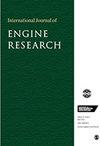Transient NOx emission modeling of a hydrogen-diesel engine using hybrid machine learning methods
IF 2.1
4区 工程技术
Q2 ENGINEERING, MECHANICAL
引用次数: 0
Abstract
One promising approach to reduce carbon foot print of internal combustion engines (ICEs) is using alternative fuels like hydrogen, particularly by converting medium and heavy-duty diesel engines to dual-fuel hydrogen-diesel engines. To minimize elevated NOx emissions from hydrogen-fueled engine, fast and accurate emission models are essential for engine model-based control and for engine calibration and optimization using hardware-in-the-loop (HIL) setups. In this study, a fast-response NOx emissions sensor is used to measure the transient NOx emissions from a dual-fuel hydrogen-diesel engine. Subsequently, steady-state models (SSMs), quasi steady-state models (QSSMs), and transient sequential models (TSMs) in the form of black-box (BB) and gray-box (GB) models are developed for transient NOx emissions prediction. GB models utilize both information from a one dimensional (1D) physical engine model and experimental data for training, while BB models only use experimental data. SSMs are optimized artificial neural networks (ANNs) trained using steady-state data, QSSMs are optimized ANNs trained using transient data, and TSMs are time-series networks trained using transient data. Long short-term memory (LSTM) and gated recurrent unit (GRU) networks are used as the time-series deep learning networks. The results showed that the 1D physical model has the poorest performance with successive model performance improvement from SSM to QSSM and from QSSM to TSM. The developed BB TSM model in this study can predict transient NOx emissions with an R使用混合机器学习方法建立氢-柴油发动机的瞬态氮氧化物排放模型
减少内燃机(ICE)碳足迹的一个可行方法是使用氢等替代燃料,特别是将中型和重型柴油发动机转换为氢柴油双燃料发动机。为了最大限度地减少氢燃料发动机的氮氧化物排放,快速准确的排放模型对于基于发动机模型的控制以及使用硬件在环(HIL)设置进行发动机标定和优化至关重要。本研究使用快速响应氮氧化物排放传感器测量氢柴油双燃料发动机的瞬态氮氧化物排放。随后,开发了稳态模型(SSM)、准稳态模型(QSSM)和瞬态连续模型(TSM),分别以黑箱(BB)和灰箱(GB)模型的形式进行瞬态氮氧化物排放预测。GB 模型利用来自一维(1D)物理发动机模型和实验数据的信息进行训练,而 BB 模型仅使用实验数据。SSM 是使用稳态数据训练的优化人工神经网络 (ANN),QSSM 是使用瞬态数据训练的优化人工神经网络,TSM 是使用瞬态数据训练的时间序列网络。长短期记忆(LSTM)和门控递归单元(GRU)网络被用作时间序列深度学习网络。结果表明,一维物理模型的性能最差,而从 SSM 到 QSSM,以及从 QSSM 到 TSM,模型性能逐次提高。本研究中开发的 BB TSM 模型可预测瞬态氮氧化物排放,在每秒预测 89,000 次的情况下,R2 值大于 0.96,因此该模型适用于对计算效率要求较高的基于模型的实时发动机控制。所开发的 GB TSM 模型可以预测瞬态氮氧化物排放,R2 值大于 0.97,但计算成本较高。GB TSM 模型的额外精度使其成为 HIL 设置的最佳选择,因为在这种情况下,计算能力更强,精度也更为重要。
本文章由计算机程序翻译,如有差异,请以英文原文为准。
求助全文
约1分钟内获得全文
求助全文
来源期刊

International Journal of Engine Research
工程技术-工程:机械
CiteScore
6.50
自引率
16.00%
发文量
130
审稿时长
>12 weeks
期刊介绍:
The International Journal of Engine Research publishes high quality papers on experimental and analytical studies of engine technology.
 求助内容:
求助内容: 应助结果提醒方式:
应助结果提醒方式:


